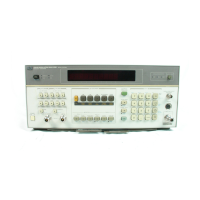Model 8901B General Information
High Selectivity Measurements.
Options 030-037 add selective power measurement capability
to
the
HP
8901B Modulation Analyzer. Used with
a
low-noise external
LO,
the
HP
8901B performs fast,
accurate single-sideband (SSB) carrier noise measurements
to
1.4 GHz.
RF Frequency Measurements
In automatic operation, the Modulation Analyzer
has
the performance
of
a
high-quality, 150 kHz
to
1300 MHz frequency counter. The frequency counter automatically adjusts itself
as
the input level
changes. There
is
no need
to
manually set or adjust the input attenuator. Because the Modulation
Analyzer is usually used
to
measure modulated signals,
its
frequency counter
also
accurately measures
signals with significant levels of AM.
Modulation Measurements
The Modulation Analyzer has extremely low internal noise. Incidental AM, FM, and QM can be
measured on a wide range of simple and complex modulated signals. To complement
its
modulation
measurement capability, the HP 8901B characterizes audio signal level, frequency, and distortion.
(These features are also available for external audio signals.)
Filters, De-emphasis Networks and Modulation Calibrators
Post-Detection Audio Filters.
The Modulation Analyzer has
two
high-pass and three low-pass post-
detection audio
filters
for filtering the recovered modulation. These filters can be selected individually
or
in
combination. Their cutoff frequencies have been chosen
to
match those needed for applications
such
as
transmitter or signal generator testing. The
>20
kHz filter
is
a Bessel filter.
It
minimizes
overshoot for square-wave modulation
so
that this type of modulating waveform can
also
be accurately
measured.
De-Emphasis Networks.
The Modulation Analyzer contains four de-emphasis networks
that
can be
used
in
addition
to
the audio filters. These are the ones commonly used
in
FM communications-25,
50, 75, and 750
ps.
When selected, the de-emphasis networks always affect the demodulated output.
You can select whether the de-emphasis network affects the deviation measured. The ability
to
select
either the actual or “de-emphasized deviation” increases the usefulness of the Modulation Analyzer in
many applications.
Modulation Calibrators.
One of the most difficult problems involved in making very accurate
measurements
of
AM
depth or FM deviation
is
generating
a
precisely modulated signal
to
use as
a
calibration standard. In all instruments, a precise AM and FM modulation standard
is
included.
When the output of the calibrator
is
connected
to
the Modulation Analyzer’s input, the amount
of modulation
is
measured to create a calibration factor. The calibration factor can be used
to
automatically compensate
all
subsequent measurements. The calibration factor is the ratio of the
measured modulation
to
the internally-computed modulation of the calibrator, expressed in
7%.
Additional Features
Tuning Features.
In automatic operation, the Modulation Analyzer automatically tunes
to
the input
signal and measures it.
In manual operation, you can determine the frequency
to
which the Modulation Analyzer tunes.
Entering the approximate frequency on the keyboard causes all but very close interfering signals
to
be
eliminated. This allows the Modulation Analyzer
to
selectively measure signals other ‘than the largest.
A track mode feature enables you to track a signal,
as
it
changes frequency, from either automatic or
manual tune operation.
1-7

